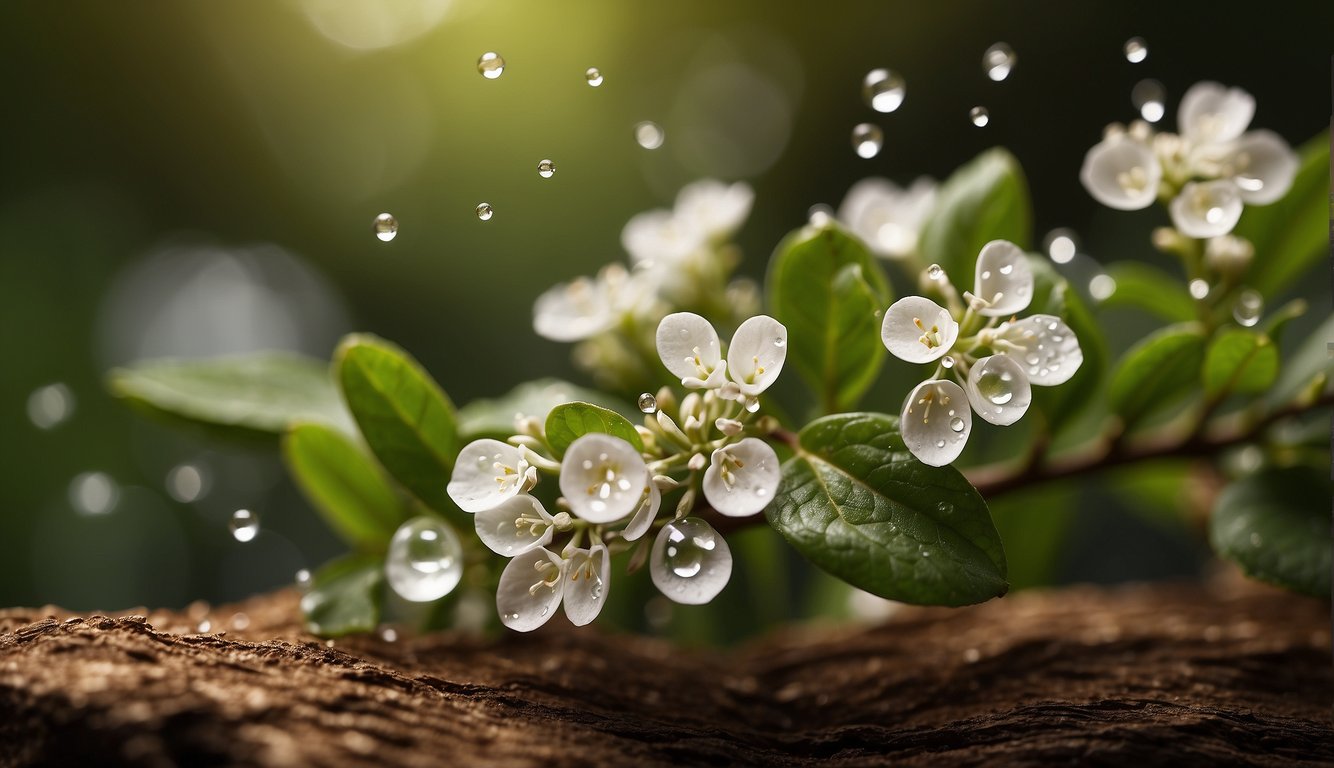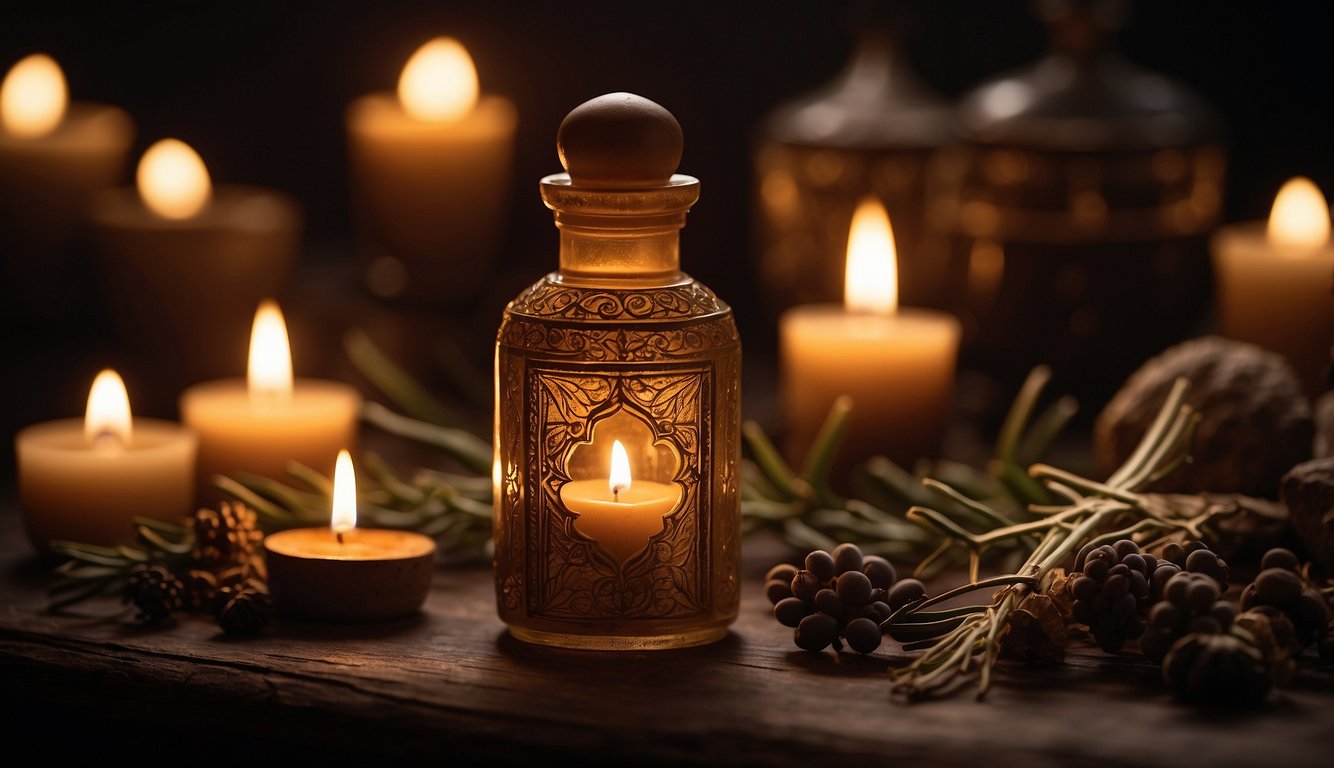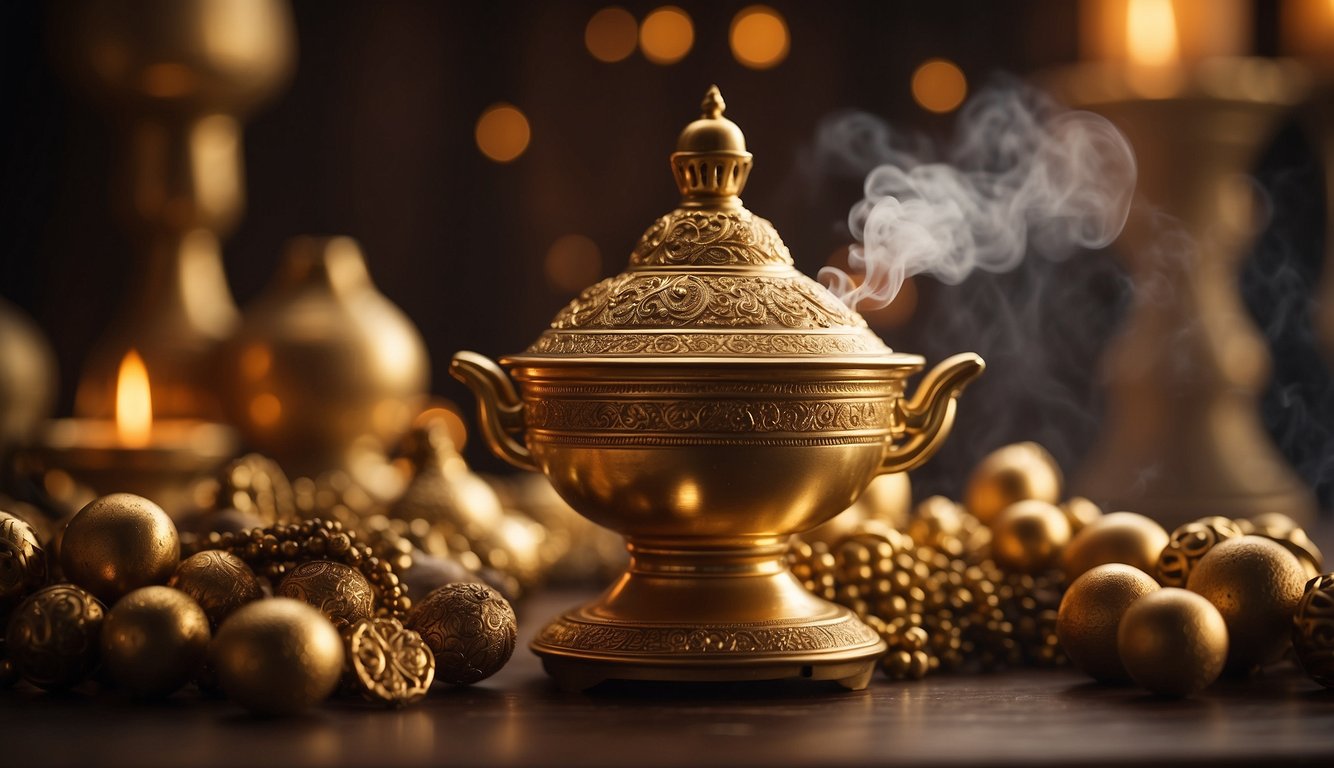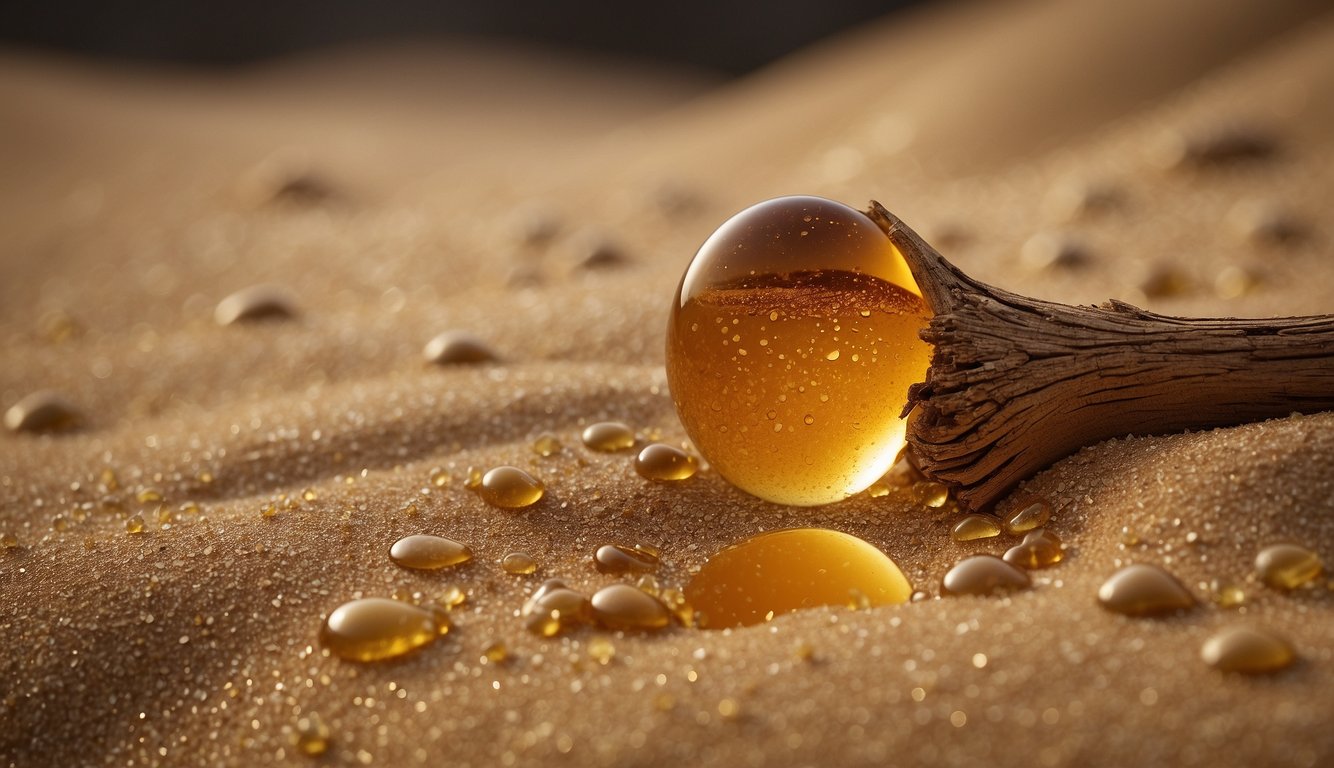Biblical myrrh is a fragrant resin with thousands of years of use for its medicinal and aromatic properties. Mentioned numerous times in the Bible, it was a valuable commodity in ancient times. Myrrh was one of the gifts brought by the wise men to the infant Jesus, along with gold and frankincense.
In the Old Testament, myrrh was used as a component of the holy anointing oil used in religious rituals. It was also used in embalming and as a perfume. Myrrh was a symbol of purification and sanctification and was often used to anoint the bodies of the deceased before burial. In the New Testament, myrrh was used to embalm the body of Jesus after his crucifixion.
Today, myrrh is still used for its medicinal and aromatic properties. It is believed to have anti-inflammatory, antiseptic, and analgesic properties and has been used to treat a variety of ailments, including respiratory problems, digestive issues, and skin conditions. Its warm, earthy scent is also popular in perfumes and other fragrances.
Historical Significance

As a substance that has been used for centuries, myrrh holds a significant place in ancient cultures. In this section, I will discuss the historical significance of myrrh, including its use in ancient cultures and its references in the Bible.
Myrrh in Ancient Cultures
Myrrh was used in ancient cultures for various purposes. The Egyptians used myrrh in their embalming process, and the Greeks used it as a perfume. The Romans used myrrh as incense, and it was also used in medicine to treat various ailments.
Biblical References
Myrrh is mentioned several times in the Bible, both in the Old and New Testaments. In the Old Testament, myrrh was used as a component in the holy anointing oil (Exodus 30:23) and as a perfume (Esther 2:12). Myrrh is also mentioned in the Song of Solomon (1:13; 3:6; 4:6, 14; 5:1, 5, 13) and in Psalms (45:8; 133:2).
In the New Testament, myrrh was one of the gifts brought by the Magi to the baby Jesus (Matthew 2:11). Myrrh was also used to anoint Jesus’ body after his crucifixion (John 19:39).
According to Easton’s Bible Dictionary, myrrh was used in the purification of women (Esther 2:12), in the consecration of priests (Exodus 30:23), and in the burial of the dead (John 19:39).
Myrrh has a rich history in ancient cultures and holds significant references in the Bible. Its use in various aspects of life, such as medicine, embalming, and perfume, highlights its importance in ancient times. Its biblical references show its significance in religious practices and rituals.
Myrrh in Christian Tradition

Myrrh has played an important role in Christian tradition for centuries. It is mentioned several times in the Bible and is associated with significant events in the life of Jesus. In this section, I will discuss the symbolism and use of myrrh in religious rituals and its significance in the life of Jesus.
Symbolism and Use in Religious Rituals
Myrrh was used in religious rituals as a symbol of purification and sanctification. It was a component of the holy anointing oil used to consecrate the tabernacle, the ark of the covenant, and the priests (Exodus 30:23-25). Myrrh was also used as a perfume and incense in the temple (Song of Solomon 3:6, Psalm 45:8). The use of myrrh in religious rituals highlights its symbolic significance as a purifying agent.
Myrrh and the Life of Jesus
Myrrh is associated with the life of Jesus in several ways. According to the Gospel of Matthew, the wise men brought gifts of gold, frankincense, and myrrh to the baby Jesus (Matthew 2:11). This event is celebrated as the Feast of Epiphany in the Christian liturgical calendar. The gifts of the wise men symbolize the divinity, priesthood, and death of Jesus.
Myrrh is also associated with the death and burial of Jesus. According to the Gospel of Mark, Jesus was offered wine mixed with myrrh on the cross, but he refused to drink it (Mark 15:23). After Jesus died, Nicodemus brought a mixture of myrrh and aloes to embalm his body (John 19:39). Myrrh was used to anoint the body of Jesus before burial, which is a symbol of his kingship and divinity.
Myrrh has been an important symbol in Christian tradition for centuries. Its use in religious rituals highlights its symbolic significance as a purifying agent. Myrrh is associated with the life of Jesus in several ways, including the gifts of the wise men, his death on the cross, and his burial.
Botanical Profile

Myrrh Tree Characteristics
I find the Commiphora myrrha tree fascinating. This small, deciduous shrub can grow up to 16 feet in height and is known for its myrrh-producing capabilities. The tree is native to the Arabian Peninsula, Somalia, and Ethiopia. It thrives in arid regions and has developed adaptations to survive in such harsh environments.
The bark of the Commiphora myrrha tree is thin and smooth, and the leaves are small and sparse. The tree produces small, fragrant flowers that are yellow to red in color. The flowers give way to small, round fruits that are green when unripe and turn brown as they mature.
Harvesting and Extraction
The gum-resin extracted from the Commiphora myrrha tree is known as myrrh. Myrrh has been used for centuries for medicinal and religious purposes. The harvesting of myrrh involves making incisions in the bark of the tree to release the resin. The resin then hardens into small, irregularly shaped pieces that are collected and sorted by size and quality.
The process of extracting myrrh is labor-intensive and requires skill and experience. The collected resin is washed, dried, and sorted again before being packaged for sale. Myrrh is used in perfumes, cosmetics, and incense. It is also used in traditional medicine to treat a variety of ailments such as inflammation, pain, and infections.
In addition to the Commiphora myrrha tree, other species of the Commiphora genus, such as C. villosus, C. salviaefolius, and C. creticus, are known for their myrrh-producing capabilities. These trees are found in Africa and Arabia and produce myrrh of varying quality and fragrance.
The Commiphora myrrha tree is a fascinating plant with a rich history and many uses. Its gum-resin, myrrh, has been valued for centuries for its fragrance and medicinal properties. The harvesting and extraction of myrrh are labor-intensive processes that require skill and experience.
Biblical Myrrh in Cultural Practices

Myrrh has a rich history of use in various cultural practices, including traditional medicine, cosmetic and perfumery uses. As a fragrant resin, myrrh has been used in beauty treatments and religious ceremonies for centuries.
Biblical Myrrh Traditional Medicine
Myrrh has been used in traditional medicine for its medicinal properties. In Chinese medicine, myrrh is used to treat a variety of ailments, including pain, swelling, and infections. It is also used to improve blood circulation and promote healing.
Myrrh has been used in medicine since ancient times. It was used as an ointment to treat wounds and infections. Myrrh was also used to treat digestive issues and respiratory problems. Today, myrrh is still used in some medicines to treat inflammation and pain.
Biblical Myrrh Cosmetic and Perfumery Uses
Myrrh has been used in cosmetics and perfumes for its fragrant and medicinal properties. Myrrh essential oil is used in perfumes, soaps, and other beauty products. It is also used in hair care products to promote healthy hair growth.
Myrrh has been used in beauty treatments for centuries. It was used in ancient Egypt to preserve the skin and prevent wrinkles. Myrrh was also used in ancient Greece and Rome as a perfume and to treat various skin conditions.
Myrrh has been used in various cultural practices for centuries. Its medicinal and cosmetic properties have made it a valuable commodity in traditional medicine, cosmetics, and perfumery.
Biblical Myrrh Economic and Trade Aspects

Trade Routes and Historical Value
Myrrh has been an important trade commodity since ancient times, and its value has been well-documented in the Bible and other historical texts. The trade routes for myrrh extended from the Arabian Peninsula to the Middle East, Abyssinia, India, and Egypt. The trade of myrrh was a significant source of income for these regions, and it was often traded alongside other valuable commodities such as frankincense, spices, and gold.
Myrrh was particularly valuable in ancient times due to its many uses. It was used for medicinal purposes, as a perfume, and as an embalming agent. In fact, myrrh was one of the key ingredients used in the embalming process for mummies in ancient Egypt. Its value was also tied to its rarity, as it could only be harvested from certain trees that grew in specific regions.
Contemporary Market for Myrrh – Myrrh Essential Oil 100ML – Get Yours Here.
Today, myrrh is still harvested and traded, although its use and value have changed somewhat. While it is still used for medicinal purposes and in perfumes, it is no longer as widely used as it once was. However, there is still a market for myrrh, particularly in the Middle East and India.
The value of myrrh today is largely dependent on its quality and purity. There are different grades of myrrh, with the highest quality being the most valuable. Myrrh is typically sold in resin form, and it can be difficult to determine its quality without a trained eye.
Myrrh has a rich history as a valuable trade commodity, and its value has been well-documented in historical texts. While its use and value have changed somewhat over time, myrrh is still harvested and traded today, particularly in the Middle East and India.
Cultural and Religious Symbolism

As a highly valued commodity in ancient times, myrrh has been used for various cultural and religious purposes. From literature to art, from rituals to ceremonies, myrrh has played a significant role in the history of many cultures, including the Hebrews.
Myrrh in Literature and Art – Myrrh Essential Oil 100ML – Get Yours Here.
Myrrh has been mentioned in various literary works, including the Bible. In the Old Testament, myrrh is mentioned as one of the ingredients of the holy anointing oil used by the priests to consecrate the tabernacle and its furnishings. Myrrh is also mentioned in the Song of Solomon, where it is used as a metaphor for the beloved’s fragrance.
In art, myrrh is often depicted as a gift to kings and queens, symbolizing their wealth and power. This is seen in the story of the Magi, who brought gifts of gold, frankincense, and myrrh to the baby Jesus. Myrrh is also often depicted in religious paintings, where it is used as a symbol of sacrifice and suffering.
Ritualistic and Ceremonial Uses
Myrrh has been used in various rituals and ceremonies throughout history. In ancient Egypt, it was used in the embalming process to preserve the bodies of the dead. In the Hebrew culture, myrrh was used as a component of the holy anointing oil, which was used to consecrate the tabernacle and its furnishings.
Myrrh was also used in the burial process. In the New Testament, myrrh is mentioned as one of the gifts brought by the Magi to the baby Jesus. This gift of myrrh was symbolic of the suffering and sacrifice that Jesus would later endure.
Myrrh has played a significant role in the cultural and religious history of many civilizations, including the Hebrews. Its symbolism has been used in literature, art, and various rituals and ceremonies throughout history.
Biblical Myrrh in Modern Usage
As a resin with a long history of use, myrrh has been utilized for various purposes, including medicinal, cosmetic, and spiritual purposes. In modern times, myrrh continues to be used for its unique properties.
Contemporary Medicinal Applications
Myrrh has been used for centuries for medicinal purposes. It has been used to treat a variety of ailments, including digestive issues, respiratory problems, and skin conditions. Myrrh contains compounds that have anti-inflammatory and antimicrobial properties, making it effective in treating infections and reducing inflammation.
In modern medicine, myrrh is still used in several ways. It is used in some toothpaste and mouthwash products due to its antibacterial properties. Myrrh is also used in some topical creams and ointments to treat skin conditions such as eczema and psoriasis.
Modern Perfumery and Aromatherapy
Myrrh has been used in perfumery and aromatherapy for thousands of years. It has a warm, earthy scent that is often used as a base note in perfumes. Myrrh is also used in incense and scent-bags due to its pleasant aroma.
Today, myrrh is still used in perfumery and aromatherapy. It is often combined with other fragrances such as cinnamon and olive oil to create unique scents. In aromatherapy, myrrh is used to promote relaxation and reduce stress.
Overall, myrrh continues to be a valuable substance with a wide range of uses. Whether it is being used for medicinal purposes or in perfumery and aromatherapy, myrrh’s unique properties make it a versatile and valuable substance.
Linking Biblical Myrrh to TheHerbProf.com
Myrrh is a resin with a rich history of medicinal use, and at TheHerbProf.com, we’re all about celebrating these herbal wonders! Here’s how our website and this subject harmonize:
- Myrrh Mysteries: We provide comprehensive information about myrrh, its medicinal properties, and its uses in herbal medicine.
- Herbal Highlights: Our site offers insights into how myrrh can be incorporated into your herbal regimen.
- Safety Measures: We guide you on how to use myrrh safely and effectively.
- Health and Wellness: Our focus is on promoting overall health and wellness, and myrrh plays a crucial role in this.
- Community Connection: Connect with others who are interested in myrrh and share your experiences.
So, whether you’re a myrrh enthusiast or just starting your herbal journey, TheHerbProf.com is your trusted guide. Remember, stay curious and stay healthy!
References:
Little Herb Encyclopedia, by Jack Ritchason; N.D., Woodland Publishing Incorporated, 1995
The Ultimate Healing System, Course Manual, Copyright 1985, Don Lepore
Planetary Herbology, Michael Tierra, C.A., N.D., Lotus Press, 1988
Handbook of Medicinal Herbs, by James A. Duke, Pub. CRP Second Edition 2007
The Complete Medicinal Herbal, by Penelope Ody, Published by Dorling Kindersley
Before You Go – Check the Following Articles!
Frequently Asked Questions – Biblical Myrrh

What is the spiritual significance of myrrh in biblical texts?
Myrrh has a significant spiritual significance in the Bible. It is often associated with death, suffering, and sacrifice and is mentioned in the Bible as an anointing oil. In the Old Testament, myrrh was used as a primary ingredient in holy anointing oil, as mentioned in Exodus 30:23. In the New Testament, myrrh was offered to Jesus at his crucifixion, which can be seen as a foreshadowing of Jesus’ suffering.
How was myrrh used ceremonially or ritually in biblical times?
Myrrh was used ceremonially or ritually in biblical times as an anointing oil. It was also used as a perfume, incense, and embalming agent. In the Old Testament, myrrh was used as a primary ingredient in holy anointing oil, as mentioned in Exodus 30:23. In the New Testament, myrrh was offered to Jesus at his crucifixion.
What does the gift of myrrh represent in the story of the Magi?
In the story of the Magi, the gift of myrrh represents the acknowledgment of Jesus’ divinity and his ultimate sacrifice. The Magi brought gifts of gold, frankincense, and myrrh to honor and acknowledge Jesus as the King of the Jews. Myrrh was a valuable gift and was often used as an anointing oil, which symbolized Jesus’ sacrifice and death.
In what ways did biblical figures utilize myrrh for anointing?
Biblical figures utilized myrrh for anointing in several ways. In the Old Testament, myrrh was used as a primary ingredient in holy anointing oil, as mentioned in Exodus 30:23. In the New Testament, myrrh was offered to Jesus at his crucifixion. Mary of Bethany anointed Jesus’ feet with a costly perfume made of pure nard, which contained myrrh, as mentioned in John 12:3.
What is the modern equivalent of myrrh mentioned in the Bible?
The modern equivalent of myrrh mentioned in the Bible is an essential oil made from the resin of the Commiphora tree. It is used for its medicinal and therapeutic properties and is often used as a fragrance in perfumes and cosmetics.
How are frankincense and myrrh connected in biblical narratives?
Frankincense and myrrh are connected in biblical narratives as they were both valuable gifts brought by the Magi to honor and acknowledge Jesus as the King of the Jews. They were also both used as anointing oils and incense in biblical times.

